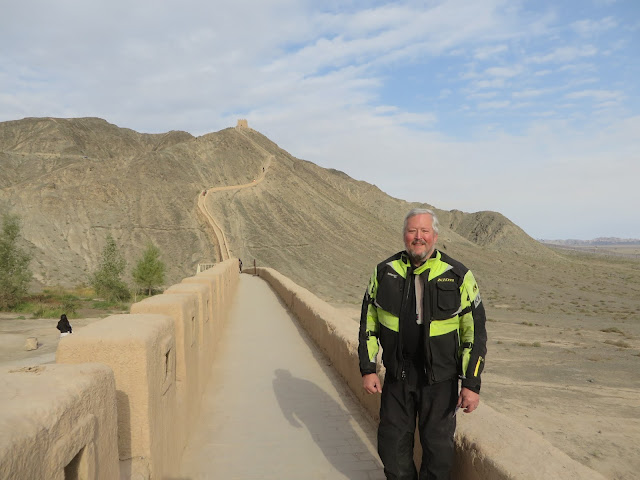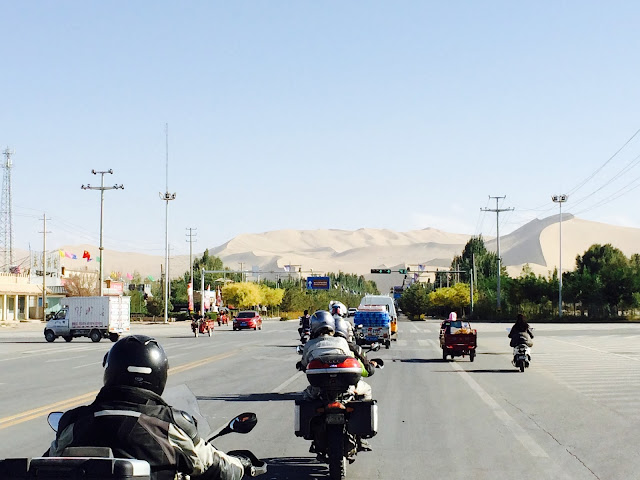Today we left our new, well appointed, but empty hotel at
8am.
Across the street is Donghu – a 38
meter, meteorological tower designed to look like a dolphin.
David posted a nighttime video of this monstrosity on Facebook - it has an incredible light show that goes all night, changing colors and making music.
The early start was necessitated by our first stop; the
Overhanging Great Wall.
On our way to the park, we had the opportunity to witness a
holdover from the Mao regime.
These bank
employees were outside doing their morning exercises as we passed.
The Hanging Wall guards the pass between the Qilian Shan and
Heishan Mountains in the Mozong Shan mountain range.
Originally built around 1539, most of this part of the wall
was re-constructed in 1987.
Admission is charged by height.
Mike should pay double the adult charge (he's 6'7")
We took the obligatory picture with the motorcycle…
…and started climbing to the top.
Yep – that’s exactly how it looked to us.
These well-worn steps must be part of the original 1539 construction.
Geoffrey encouraged us along (really more like taunting).
We didn’t stop at the first tower, but marched on towards
the next and highest tower.
The views were spectacular to the west.
Not so spectacular towards the power plant in the east.
Dave joined me in the last outpost of the Great Wall of
China.
Even though we had over 236 miles on the road today, the
hour spent at the wall was well worth it.
A great stop and tromp through history.
Back on the national road, we made a brief stop to photograph
camels and the herder.
We passed another mosque.
It just doesn’t seem right to see Chinese on the front of
it.
The first gas stop of the day featured this cute little guy.
He could barely get up the step behind him
to go inside.
The national road today had it’s own very special ways to
challenge us.
It was very narrow and
many of the trucks did not want to give us any room on the pavement.
Even when we did have blacktop, the dust the trucks kicked up
often blinded the riders.
Encountering trucks on the narrow overpasses over the freeway was
hai
ry.
It was best to wait for them to exit the overpass.
Lunch was in a gas station parking lot.
Luckily, I found these pressure packed chicken legs at our
last stop.
The dusty, narrow national road began to fray our
nerves.
Every time we passed over it, we
asked “Why can’t we get on the freeway?!”
What a stupid rule.
At one point we had the smooth freeway on one side and the
efficient railway on the other and as David said, “We’re stuck on this sand goat
track in the Gobi desert!”
Gas stations are few and far between, so this was our
afternoon rest stop - a little hard for the ladies to find privacy.
Worse than the dusty roads, was this underpass full of
sand.
It’s very hard to keep the bike
upright and moving when the ground under isn’t stable.
We did find relief at a fruit stand, where we were
introduced to a yellow watermelon.
Delicious.
Leaving the fruit stand, John decided to let Yingchu sit in front and "drive."
These locals enjoyed the sight of nine motorcycles roaring
down the road.
All along the roadside we saw melons hung up to dry in the
sun. But I asked myself if I really
wanted sun-dried, dust covered, polluted melon.
Nope.
Although the national road was better after the fruit stand,
I still envied the pigs going to market on the freeway.
It was getting late and this was the third
day of traveling well into the afternoon on bad, dusty roads.
All of a sudden, we ran out of road.
Just past the underpass was a huge ditch and
the road ended.
John scouted up over the
bridge – nada - the overpass road also ended suddenly.
But Mike found a way.
He’s on the freeway!
Yay!
One minor problem, we have to get from the gas station
parking lot to the freeway on a narrow ledge, as a guard rail blocks access to the highway.
Success –we made it with only minor damage when the left
pannier hit the barrier.
We rode the
rest of the way to Dunhuang on the G30. Our stop tonight is the Silk Road Dunhuang Hotel.
The city of Dunhuang was a major stop on the
Silk Road.
We were totally unprepared for the immense sand
dunes that rose from the road as we made the final turn towards our hotel.
Breathtaking.
The hotel is built in a traditional Chinese rammed-mud style and
looks like a fort.
The upstairs rooftop restaurant
has great views of the sand dunes.
Tomorrow we will have a great opportunity to see the Caves
of Magao. Over a thousand years of
Buddhists art was preserved in caves.



















































